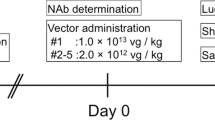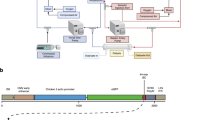Abstract
To increase transgene expression in the liver, electric pulses were applied to the left lateral lobe after intravenous injection of naked plasmid DNA (pDNA) or pDNA/liver targeting vector complex prepared with galactosylated poly(L-lysine) or galactosylated polyethyleneimine. Electroporation (250 V/cm, 5 ms/pulse, 12 pulses, 4 Hz) after naked pDNA injection dramatically increased the expression up to 200 000-fold; the expression level obtained was significantly greater than that achieved by the combination of pDNA/vector complex and electroporation. We clearly demonstrated that the expression was dependent on the plasma concentration of pDNA at the time when the electric pulses were applied. Separation of liver cells revealed that the distribution of naked pDNA as well as transgene expression was largely selective to hepatocytes in the electroporated lobe. The number of cells expressing transgene product using vascularly administered naked pDNA followed by electroporation was significantly (P<0.01) greater and more widespread than that obtained by local injection of naked pDNA. These results indicate that the application of in vivo electroporation to vascularly administered naked pDNA is a useful gene transfer approach to a large number of hepatocytes.
This is a preview of subscription content, access via your institution
Access options
Subscribe to this journal
Receive 12 print issues and online access
$259.00 per year
only $21.58 per issue
Buy this article
- Purchase on Springer Link
- Instant access to full article PDF
Prices may be subject to local taxes which are calculated during checkout










Similar content being viewed by others
References
Nishikawa M, Huang L . Nonviral vectors in the new millennium: delivery barriers in gene transfer. Hum Gene Ther 2001; 12: 861–870.
Nishikawa M et al. Hepatocyte-targeted in vivo gene expression by intravenous injection of plasmid DNA complexed with synthetic multi-functional gene delivery system. Gene Therapy 2000; 7: 548–555.
Morimoto K et al. Molecular weight-dependent gene transfection activity of unmodified and galactosylated polyethyleneimine on hepatoma cells and mouse liver. Mol Ther 2003; 7: 254–261.
Kawakami S et al. Mannose receptor-mediated gene transfer into macrophages using novel mannosylated cationic liposomes. Gene Therapy 2000; 7: 292–299.
Titomirov AV, Sukharev S, Kistanova E . In vivo electroporation and stable transformation of skin cells of newborn mice by plasmid DNA. Biochim Biophys Acta 1991; 1088: 131–134.
Huber PE, Pfisterer P . In vitro and in vivo transfection of plasmid DNA in the Dunning prostate tumor R3327-AT1 is enhanced by focused ultrasound. Gene Therapy 2000; 7: 1516–1525.
Liu F, Song YK, Liu D . Hydrodynamics-based transfection in animals by systemic administration of plasmid DNA. Gene Therapy 1999; 6: 1258–1266.
Zhang G, Budker V, Wolff JA . High levels of foreign gene expression in hepatocytes after tail vein injections of naked plasmid DNA. Hum Gene Ther 1999; 10: 1735–1737.
Somiari S et al. Theory and in vivo application of electroporative gene delivery. Mol Ther 2000; 2: 178–187.
Belehradek M et al. Electrochemotherapy, a new antitumor treatment. First clinical phase I–II trial. Cancer 1993; 72: 3694–3700.
Mir LM et al. Effective treatment of cutaneous and subcutaneous malignant tumors by electrochemotherapy. Br J Cancer 1998; 77: 2336–2342.
Heller R et al. In vivo gene electroinjection and expression in rat liver. FEBS Lett 1996; 389: 225–228.
Suzuki T et al. Direct gene transfer into rat liver cells by in vivo electroporation. FEBS Lett 1998; 425: 436–440.
Rols MP et al. In vivo electrically mediated protein and gene transfer in murine melanoma. Nat Biotechnol 1998; 16: 168–171.
Aihara H, Miyazaki J . Gene transfer into muscle by electroporation in vivo. Nat Biotechnol 1998; 16: 867–870.
Hickman MA et al. Gene expression following direct injection of DNA into liver. Hum Gene Ther 1994; 5: 1477–1483.
Liu F, Huang L . Electric gene transfer to the liver following systemic administration of plasmid DNA. Gene Therapy 2002; 9: 1116–1119.
Kawabata K, Takakura Y, Hashida M . The fate of plasmid DNA after intravenous injection in mice: involvement of scavenger receptors in its hepatic uptake. Pharm Res 1995; 12: 825–830.
Kobayashi N et al. Hepatic uptake and gene expression mechanisms following intravenous administration of plasmid DNA by conventional and hydrodynamics-based procedures. J Pharmacol Exp Ther 2001; 297: 853–860.
Nishikawa M, Takemura S, Takakura Y, Hashida M . Targeted delivery of plasmid DNA to hepatocytes in vivo: Optimization of the pharmacokinetics of plasmid DNA/galactosylated poly(L-lysine) complexes by controlling their physicochemical properties. J Pharmacol Exp Ther 1998; 287: 408–415.
Takakura Y et al. Characterization of plasmid DNA binding and uptake by peritoneal macrophages from class A scavenger receptor knockout mice. Pharmacol Res 1999; 16: 503–508.
O’hara AJ et al. The spread of transgene expression at the site of gene construct injection. Muscle Nerve 2001; 24: 488–495.
Nishikawa M, Hashida M . Nonviral approaches satisfying various requirements for effective in vivo gene therapy. Biol Pharm Bull 2002; 25: 275–283.
Wagner E et al. Influenza virus hemagglutinin HA-2 N-terminal fusogenic peptides augment gene transfer by transferrin-polylysine-DNA complexes: toward a synthetic virus-like gene-transfer vehicle. Proc Natl Acad Sci USA 1992; 89: 7934–7938.
Boussif O et al. A versatile vector for gene and oligonucleotide transfer into cells in culture and in vivo: polyethylenimine. Proc Natl Acad Sci USA 1995; 92: 7297–7301.
Budker V, Zhang G, Knechtle S, Wolff JA . Naked DNA delivered intraportally express efficiently in hepatocytes. Gene Therapy 1996; 3: 593–598.
Zhang G et al. Expression of naked plasmid DNA injected into the afferent and efferent vessels of rodent and dog livers. Hum Gene Ther 1997; 8: 1763–1772.
Yoshida Y et al. Introduction of DNA into rat liver with a hand-held gene gun: distribution of expressed enzyme, [32P]DNA, and Ca2+ flux. Biochem Biophys Res Commun 1997; 234: 695–700.
Budker V et al. The efficient expression of intravascularly delivered DNA in rat muscle. Gene Therapy 1998; 5: 272–276.
Kobayashi N, Nishikawa M, Hirata K, Takakura Y . Hydrodynamics-based procedure involves transient hyperpermeability in the hepatic cellular membrane: implication of a nonspecific process in efficient intracellular gene delivery. J Gene Med 2004; 6: 584–592.
Canatella PJ, Prausnitz MR . Prediction and optimization of gene transfection and drug delivery by electroporation. Gene Therapy 2001; 8: 1464–1469.
Acknowledgements
This work was supported in part by Grants-in-Aid for Scientific Research from the Ministry of Education, Culture, Sports, Science and Technology, Japan, and by grants for Health and Labour Sciences Research from the Ministry of Health, Labour and Welfare, Japan.
Author information
Authors and Affiliations
Rights and permissions
About this article
Cite this article
Sakai, M., Nishikawa, M., Thanaketpaisarn, O. et al. Hepatocyte-targeted gene transfer by combination of vascularly delivered plasmid DNA and in vivo electroporation. Gene Ther 12, 607–616 (2005). https://doi.org/10.1038/sj.gt.3302435
Received:
Accepted:
Published:
Issue Date:
DOI: https://doi.org/10.1038/sj.gt.3302435
Keywords
This article is cited by
-
CRISPR somatic genome engineering and cancer modeling in the mouse pancreas and liver
Nature Protocols (2022)
-
Nanoparticles for gene delivery: therapeutic and toxic effects
Molecular & Cellular Toxicology (2014)
-
Electroporation and ultrasound enhanced non-viral gene delivery in vitro and in vivo
Cell Biology and Toxicology (2010)
-
Adenovirus serotype 35 vector-mediated transduction following direct administration into organs of nonhuman primates
Gene Therapy (2009)
-
Sine-wave Current for Efficient and Safe In Vivo Gene Transfer
Molecular Therapy (2007)



